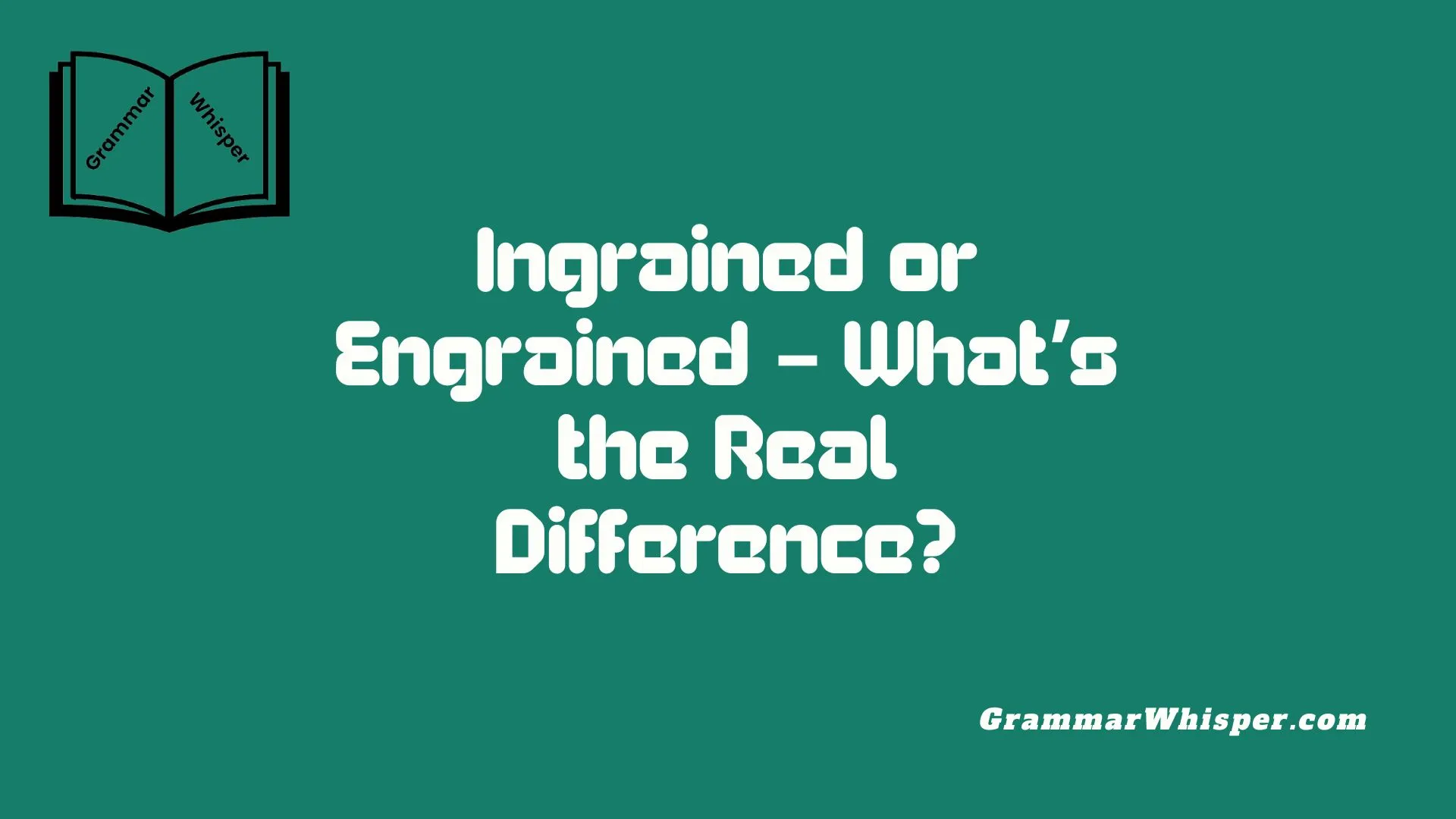When I first noticed the spelling differences between ingrained and engrained, I was deep into one of my favorite books. At first glance, both seemed identical, and it’s no wonder so many people feel confused. It’s a tricky pair, and I’ve seen them misused even in published articles. But only one is widely accepted as the correct choice in modern usage, and that’s ingrained. I gave it some real attention, did my homework, and finally came to understand what each form could mean and when to use it.
With time, I learned that ingrained has been the more preferred and historically dominant form, while engrained now feels more like a dated variant. If you’ve ever hesitated, wondering which word to choose, take it from someone who’s pored over style guides – go with ingrained. It’s not just a grammar rule; it reflects how language itself evolves. There’s no mystery once you see how vocabulary shifts and how usage becomes accepted. This tiny nuance reveals the true beauty and complexity of English, and honestly, that’s what makes learning it so deeply rewarding.
Why People Get “Ingrained” and “Engrained” Mixed Up
English is full of words that sound alike but are spelled differently, and “ingrained” and “engrained” fit that bill perfectly. Both describe something deeply fixed or firmly established, often referring to habits, beliefs, or qualities. But which spelling is right? Why does one feel more natural while the other sounds a bit odd?
The confusion comes partly from how these words evolved and partly because “ingrained” still shows up in some older or regional texts. Today, most writers, editors, and style guides favor ingrained – yet you’ll occasionally stumble upon engrained, which can throw you off.
Understanding the difference is more than a grammar lesson; it’s about knowing how English changes, how to spot outdated terms, and how to use language confidently.
What Does “Ingrained” Really Mean?
Let’s start with the star of the show – ingrained. The word means something firmly fixed, deeply rooted, or implanted in a way that’s difficult to change. Think of it like a habit or belief that’s been embedded so thoroughly, it feels natural or automatic.
Common Uses of “Ingrained”
- Habits: “His ingrained morning routine helps him start the day productively.”
- Beliefs: “Prejudices are often ingrained by early life experiences.”
- Characteristics: “Her ingrained sense of kindness shines through every action.”
You’ll find ingrained mostly describing things that have been part of a person, culture, or system for so long they’re almost second nature.
The Rare Cousin: Understanding “Engrained”
Engrained is the older sibling, less used today, but not always incorrect. It shares the same meaning as ingrained, yet it pops up less often, mostly in British English or older texts.
When Might You See “Engrained”?
- In literature from the 19th or early 20th centuries
- In some UK dialects or historical documents
- Occasionally, in poetry or stylistic writi,n,g to create a certain old-fashioned tone.
Most modern dictionaries, including Merriam-Webster and Oxford English Dictionary, list engrained as a variant but mark ingrained as the preferred form.
Origins and Etymology: Tracing Both Words Back
To understand why these two spellings exist, we need to look at where they come from.
| Word | Origin | Meaning Root |
| Ingrained | From Latin in- (in) + granum (grain) | Originally meant ‘to fix firmly in the grain or texture’ |
| Engrained | Variant spelling influenced by “engrave” | Likely influenced by “engrave,” meaning to carve deeply |
Ingrained means to implant something deeply, like a grain settling firmly inside something else. Engrained, influenced by the word engrave, might have suggested the idea of something “carved in,” which also fits the meaning.
Over time, linguists and style guides favored ingrained because it directly relates to the original Latin roots and feels more precise.
The Verbs Behind the Adjectives: Ingrain vs. Engrain
Both ingrained and engrained come from verbs – to ingrain and to engrain.
- Ingrain (verb): To firmly fix or establish an idea, habit, or attitude.
- Engrain (verb): Less common, but has the same meaning as ingrain.
In practice, the verb ingrain dominates modern usage. For example:
- “Good manners are ingrained from childhood.”
- “The habit was ingrained over years of practice.”
Using engrain as a verb is rare today and might be seen as archaic or regional.
Which Word Dominates Today? Usage Trends and Data
Let’s look at some real numbers to settle the score. When checking sources like the Google Ngram Viewer, Corpus of Contemporary American English (COCA), and British National Corpus (BNC), ingrained is overwhelmingly more popular.
| Word | Frequency (Approximate) | Comments |
| Ingrained | 100% | Standard, common in modern English |
| Engrained | <1% | Rare, mostly historical or regional |
For example, Merriam-Webster shows ingrained as the primary entry with engrained as a less common variant. The Oxford English Dictionary follows the same trend.
Visualizing this:
makefile
CopyEdit
Ingrained: ████████████████████████████
Engrained: █
Ingrained not only dominates in frequency but also formal writing, media, and education.
Real-World Examples: Using “Ingrained” Correctly in Sentences
Here are some real-world examples with explanations:
- “Her ingrained fear of public speaking made presentations challenging.” (Fear deeply rooted over time.)
- “Ingrained habits, such as checking your phone first thing in the morning, are hard to break.” (Habits fixed firmly by repetition.)
- “The community’s ingrained respect for tradition guides their decisions.” (A value deeply embedded culturally.)
Common Mistakes to Avoid
- Using ingrained phrases in formal writing without considering the audience or context
- Mixing ingrained words with unrelated words like “engrave” inappropriately
- Confusing the adjective with the verb forms
Style and Grammar Tips: When to Use “Ingrained” Over “Engrained”
Here are some handy style tips:
- Always prefer to be ingrained in professional, academic, and formal contexts.
- If writing historically or regionally (especially British English), engrained may be acceptable, but clarify your audience.
- Check your style guide – APA, Chicago Manual of Style, and Merriam-Webster all recommend ingrained.
- When in doubt, use ingrained. It’s clearer, more widely understood, and less likely to confuse.
Final Thoughts
English may seem tricky with its close siblings like ingrained and engrained, but knowing the facts puts you in the driver’s seat. Using ingrained confidence means you communicate clearly and accurately. Plus, you avoid the awkward moments of second-guessing your spelling. Now, whenever you encounter this word, you’ll know exactly which path to take.
Would you like a printable quick-reference cheat sheet or a visual infographic summarizing this guide? Just say the word!
FAQS:
What is the difference between ingrained and engrained?
Ingrained and engrained mean the same thing – something deeply fixed or firmly established. However, ingrained is the standard, widely accepted spelling today, while engrained is an older, less common variant mostly found in historical or British English texts.
Is engrained considered incorrect?
No, ingrained isn’t exactly incorrect, but it is outdated and rarely used in modern writing. Most style guides and dictionaries recommend using ingrained because it’s clearer and more common.
Can I use ingrained in formal writing?
It’s best to avoid being engrained in formal, academic, or professional writing. Stick with ingrained to ensure your writing sounds current and polished unless you’re quoting older texts or writing about historical language use.
Where did ingrained and engrained come from?
Both come from Latin roots related to “grain” or “carve.” Ingrained derives from in (in) + granum (grain), meaning something deeply fixed like a grain in fabric. Engrained likely evolved under the influence of “engrave,” meaning carved or etched in deeply.
How do I remember which one to use?
Think of ingrained as the mainstream, everyday word you’ll see in books, articles, and conversations. Engrained is the older, less common relative – fine for historical or stylistic uses, but otherwise best to avoid for clarity.











